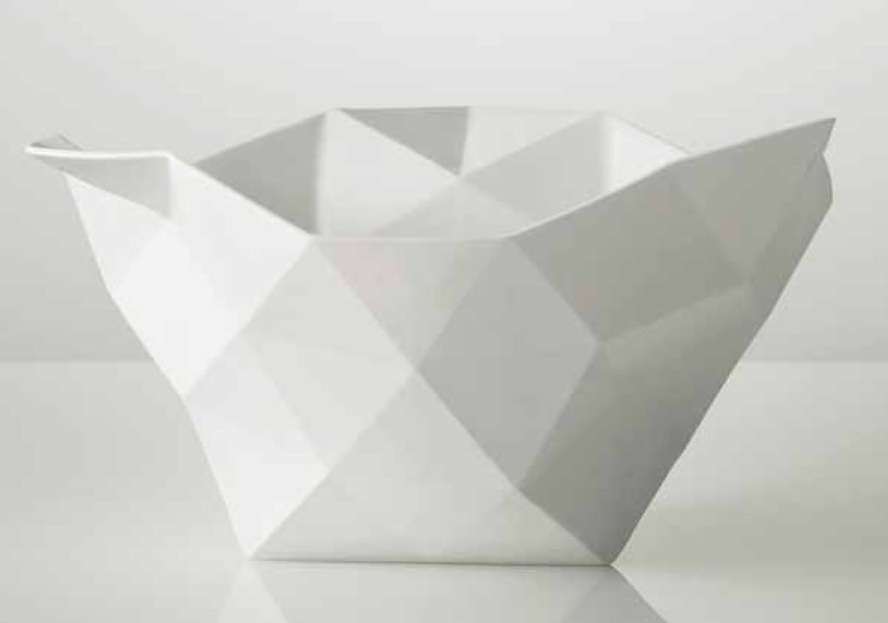The inherent strength of a material informs the nature of the shapes that can be produced from it. Strength, one of the key physical characteristics of bone china, means that it can be formed into thin, delicate sections, conveying an exquisiteness that is associated with the refined image of fine ladies drinking tea. Interesting then, that this material is partly made from a by-product of the food industry, with 50 per cent of the ingredients being made of bone ash, (calcium phosphate), the remaining ingredients are 25 per cent Kaolin (china clay) and 25 per cent quartz.
An English potter developed bone china in the eighteenth century as a result of trying to replicate porcelain from China, where it had been used for over a thousand years. Although they are both hard, white and translucent, bone china and porcelain are different materials and so require different processing, for example, bone china fires at lower temperatures to porcelain. Belonging to the vitrified – containing glass – group of ceramics the china content gives the substance its hardness, which is why it is possible to make thin, fine sections and details. The fact it is a vitreous ceramic also helps with its resistance to moisture. The colour of bone china is white but is also distinct from porcelain in that it is a slightly creamier shade of white; however, both are translucent.
Image: Crushed Bowl by JDS Architects for Muuto Denmark

Key features
•High strength means thin cross-sections
•Excellent hardness
•Less brittle than porcelain
•Good electrical resistance
•Whiter than porcelain
•Translucent
•Vitreous, making it resistant to water
•Excellent chemical resistance
•Non-porous
•Biscuit fired at around 1200ºC (2192ºF)
Sources
Kaolin, one the major ingredients in bone china, is quarried in various places in the UK, one specifically being Cornwall. In France it is quarried in Limoges. In the UK, Stoke-on-Trent is the home of many ceramic products.
The cost of the raw materials, the higher tolerance needed in firing temperatures and the general care needed in production means that relative to other ceramics it is expensive.
Sustainability issues
As an inert material, ceramics do not degrade. In order to produce ceramics an irreversible chemical reaction needs to take place, therefore, unlike thermoplastics, which can be reheated and reused, ceramics are not recyclable in the sense that they cannot be remoulded. However, they can be crushed and used as fillers and gravel for various industrial applications. The main issue with ceramics is the intense heat that is used during firing, and often, when a ceramic needs glazing, this will involve a second firing process.
Production
The production of bone china follows similar methods to other ceramics, including slip casting, extrusion, jiggering and jollying and compression moulding. Due to its strength it is ideally suited to slip casting, which allows for thin wall sections.
Typical applications
This high-grade English pottery has its main use in tableware. China clay, however, is used for making various forms of porcelain; as an abrasive powder; as a refractory material; as an electrical insulator; as a pigment in paints; and as a filler for plastic mouldings to reduce moisture absorption. Vitreous china is also used to make sanitary-ware due to it its ability to resist moisture content.
Derivatives
Cornish stone, also known as china stone. Less decomposed than china clay, containing a large amount of feldspar. Generally used as a flux and porcelain bodies.
| + | – |
|
–Very strong and hard –Water resistant –Excellent chemical resistance –Can be formed in very thin sections |
–Relatively high cost –Not recyclable –Energy intensive to produce |
